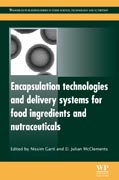
Encapsulation Technologies and Delivery Systems for Food Ingredients and Nutraceuticals
Garti, N
McClements, D J
Improved technologies for the encapsulation, protection, release and enhanced bioavailability of food ingredients and nutraceutical components are vital to the development of future foods. Encapsulation technologies and delivery systems for food ingredients and nutraceuticals provides a comprehensive guide to current and emerging techniques.Part one provides an overview of key requirements for food ingredient and nutraceutical delivery systems, discussing challenges in system development and analysis of interaction with the human gastrointestinal tract. Processing technologies for encapsulation and delivery systems are the focus of part two. Spray drying, cooling and chilling are reviewed alongside coextrusion, fluid bed microencapsulation, microencapsulation methods based on biopolymer phase separation, and gelation phenomena in aqueous media. Part three goes on to investigate physicochemical approaches to the production of encapsulation and delivery systems, including the use of micelles and microemulsions, polymeric amphiphiles, liposomes, colloidal emulsions, organogels and hydrogels. Finally, part four reviews characterization and applications of delivery systems, providing industry perspectives on flavour, fish oil, iron micronutrient and probiotic delivery systems.With its distinguished editors and international team of expert contributors, Encapsulation technologies and delivery systems for food ingredients and nutraceuticals is an authoritative guide for both industry and academic researchers interested in encapsulation and controlled release systems. Provides a comprehensive guide to current and emerging techniques in encapsulation technologies and delivery systemsChapters in part one provide an overview of key requirements for food ingredient and nutraceutical delivery systems, while part two discusses processing technologies for encapsulation and delivery systemsLater sections investigate physicochemical approaches to the production of encapsulation and delivery systems and review characterization and applications of delivery systems INDICE: Part 1 Requirements for food ingredient and nutraceutical delivery systems: Requirements for food ingredient and nutraceutical delivery systems; Challenges in developing delivery systems for food additives, nutraceuticals and dietary supplements; Interaction of food ingredient and nutraceutical delivery systems with the human gastrointestinal tract. Part 2 Processing technology approaches to produce encapsulation and delivery systems: Spray drying, freeze drying and related processes for food ingredient and nutraceutical encapsulation; Spray cooling and spray chilling for food ingredient and nutraceutical encapsulation; Coextrusion for food ingredients and nutraceutical encapsulation: Principles and technology; Fluid bed microencapsulation and other coating methods for food ingredient and nutraceutical bioactive compounds; Microencapsulation methods based on biopolymer phase separation and gelation phenomena in aqueous media. Part 3 Physicochemical approaches to produce encapsulation and delivery systems: Micelles and microemulsions as food ingredient and nutraceutical delivery systems; Biopolymeric amphiphiles as food ingredient and nutraceutical delivery systems; Liposomes as food ingredients and nutraceutical delivery systems; Colloidal emulsions and particles as micronutrient and nutraceutical delivery systems; Structured oils and fats (organogels) as food ingredient and nutraceutical delivery systems; Hydrogel particles and other novel protein-based methods for food ingredient and nutraceutical delivery systems. Part 4 Characterization and applications of delivery systems: An industry perspective on the advantages and disadvantages of different flavour delivery systems; An industry perspective on the advantages and disadvantages of different fish oil delivery systems; An industry perspective on the advantages and disadvantages of iron micronutrient delivery systems; Properties and applications of different probiotic delivery systems.
- ISBN: 978-0-85709-124-6
- Editorial: Woodhead Publishing
- Encuadernacion: Cartoné
- Páginas: 640
- Fecha Publicación: 19/10/2012
- Nº Volúmenes: 1
- Idioma: Inglés
